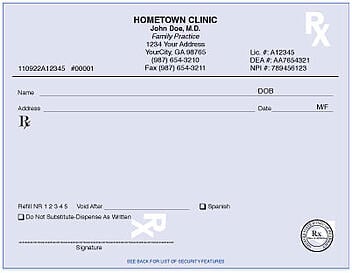Once being prescribed supplemental oxygen you will need that in order to obtain oxygen therapy, here is what your prescription will include:
- Flow Rate and Duration of Oxygen Use: This is the main basis for oxygen therapy, depending on your bodies oxygen saturation your doctor will prescribe you a flow rate that supplements the lack of oxygen.
- Delivery Method: Your doctor will recommend either using a nasal cannula or oxygen mask during oxygen therapy.
- Recommended Oxygen Delivery Method: The three methods are a portable oxygen concentrator, industry standard oxygen tanks, or liquid oxygen.
- Documentation that Supports COPD Diagnosis: This will include tests that your doctor has run that support his/her diagnosis of COPD, these documentations are required in order to receive Medicare or other insurance coverage for oxygen therapy.
- Health Insurance and Medicare Coverage: Your doctor will fill out a Certification of Medical Necessity, which is required in order to receive insurance or Medicare coverage as well as ensuring a smooth financial transition for you and your family.
With the diagnosis of COPD it is more than likely that you will maintain your prescription for the rest of your life, so it is important to keep it in a safe location. Also just like any other prescription, you should strictly follow your supplemental oxygen prescription to fully benefit from the treatment. Dealing with breathlessness is not the only symptom attributed to COPD, so just because you are able to breathe without interruption or you feel well does not mean you should go without your portable oxygen concentrator.
When Looking for an Oxygen Supplier Ask Yourself:
- How long have they been in business?
- How quickly do they replace defective equipment?
- Are they BBB (Better Business Bureau) certified, if so do they have an A+ rating?
- Do they offer a lowest price guarantee?
As COPD progresses you may need your prescription adjusted, which throughout your treatment your doctor will check your oxygen saturation levels to ensure you are being properly saturated. Oxygen saturation tests are crucial in ensuring that your oxygen levels are at a normal amount 24 hours a day. During any time throughout your treatment you feel that you are not being properly saturated, then speak with your doctor about possibly adjusting your flow rate or if you have any questions or concerns regarding your prescription then bring them up at your next doctors appointment.
A very important factor in your treatment for COPD is making sure you stay on top of and attend regular scheduled doctors appointments, this is your one on one time with your doctor and they are there to help so no matter if you think the question is meaningless, ask because you never know what will come of it or if other patients have had the same inquires.
+Caleb Umstead




